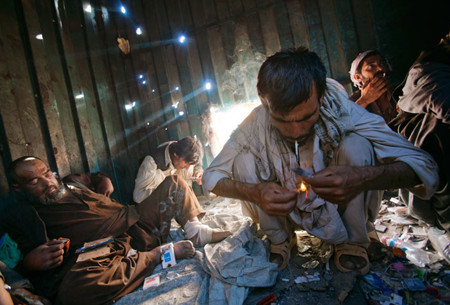By Matt Robinson
Through a blue gate, they come for treatment in the early morning, faces wrapped in scarves against the cold. For now it's a trickle, but their numbers are rising.

Reuters, Feb. 10, 2011: The source of 90 percent of the global supply of opium used to make heroin, Afghanistan has around 1 million drug users. Of those, an estimated 20,000 inject, and 80 percent of them share needles, many huddled in squalor under bridges or in abandoned buildings until they are rounded up and jailed or moved on by police. (Photo: David Guttenfelder / National Geographic)
"I try to keep it secret, especially from my mother," said a 26-year-old HIV patient at a foreign-run clinic in the Afghan capital, Kabul. "If she knew I had HIV, she would die."
Shrouded in ignorance and taboo, HIV and AIDS have crept up almost unnoticed to join the long list of misfortunes visited on Afghanistan over the past several decades.
Officially, there are 636 cases in a population of about 30 million people. Health experts say the real figure is far higher, and growing.
Set alongside an almost decade-old war, desperate poverty and a government dependent on military and financial aid to reach beyond its cities, the fight against HIV and AIDS struggles to compete for the country's meager resources.
Social stigma in a deeply conservative Muslim country has driven the disease underground and is complicating efforts to coordinate a response.
"Most U.N. agencies would say the number is in the thousands rather than the hundreds," said Olivier Vandecasteele of Medecins Du Monde, which began anti-retroviral treatment in Kabul in 2009.
Harsheth Virk, an expert in HIV/AIDS prevention and care at the U.N. Office on Drugs and Crime (UNODC) in Kabul, said: "You have these pockets where it could potentially be explosive."
Studies suggest Afghanistan currently has a "concentrated HIV/AIDS epidemic" -- concentrated within a growing population of injecting drug users.
The country's drug problem is well known.
The source of 90 percent of the global supply of opium used to make heroin, Afghanistan has around 1 million drug users.
Of those, an estimated 20,000 inject, and 80 percent of them share needles, many huddled in squalor under bridges or in abandoned buildings until they are rounded up and jailed or moved on by police.
The HIV sufferer, who spoke to Reuters on condition of anonymity, said he believes he contracted the virus when sharing needles in Iran. His account is a common one.
A majority of people registered as HIV positive in Afghanistan have lived abroad, mainly in neighboring Pakistan or Iran where rates of drug addiction are also high.
Most are homeless and jobless, part of a huge population of displaced people since the Soviet occupation of the 1980s, the civil war and Taliban rule that followed.
Few have access to testing, and those who do face being shunned by a deeply religious society that largely associates AIDS with sexual promiscuity and homosexuality -- both taboo.
"One of the biggest challenges we have is that people believe HIV is found only among those who have 'immoral' relationships," said Dr Fahim Paigham, head of Afghanistan's National AIDS Control Program.
Paigham runs the program out of a sparse port-a-cabin in the grounds of the Ministry of Health, a naked light-bulb and a photograph of President Hamid Karzai above his desk.
PRISONERS
The inauspicious surroundings speak to the challenge of funding. Most comes from foreign donors such as the World Bank, which has spent $10 million over the past three years to fight HIV and AIDS.
"It's not enough," said Virk, "and it's obviously very difficult to get donor interest in this because there are so many other issues."
Health experts say they struggle to convince government officials in charge of prisons or counter-narcotics that they are not encouraging promiscuity or drug use by distributing condoms and clean needles.
A pilot project launched last year to provide methadone to drug users, taken orally as a substitute for injecting heroin, faces problems in securing supplies.
"There have been a few hiccups," said Virk.
Prisoners are particularly vulnerable, crammed into over-crowded jails where drug use is rampant and access to clean needles and condoms limited.
One aid worker, who asked not to be identified, told the story of six prisoners, all drug users, who were transferred from a jail in western Farah province, bordering Iran, to Kabul in 2010. Once in the capital, they were tested for HIV, and all six were positive.
Health experts stress there are few cases of HIV within the sex industry or among truck drivers, often another high-risk group.
But studies suggest sex workers in Afghanistan know little about HIV, rarely use condoms and are unlikely to be tested for the disease.
"You know about the customs and culture of our country," said Dr Tariq Suliman, director of the Nejat Center for drug rehabilitation and HIV/AIDS awareness.
"The people aren't ready to talk about this issue."
(Editing by Jonathan Thatcher)



